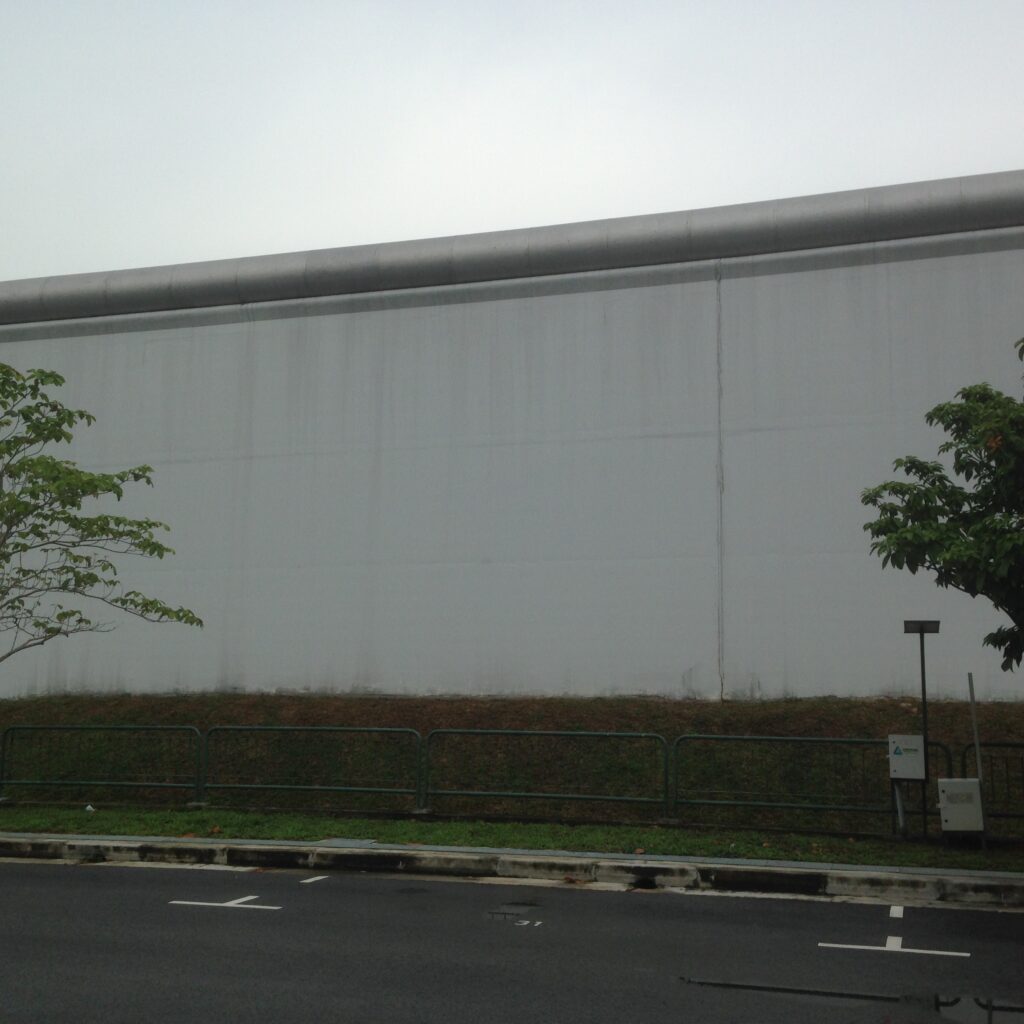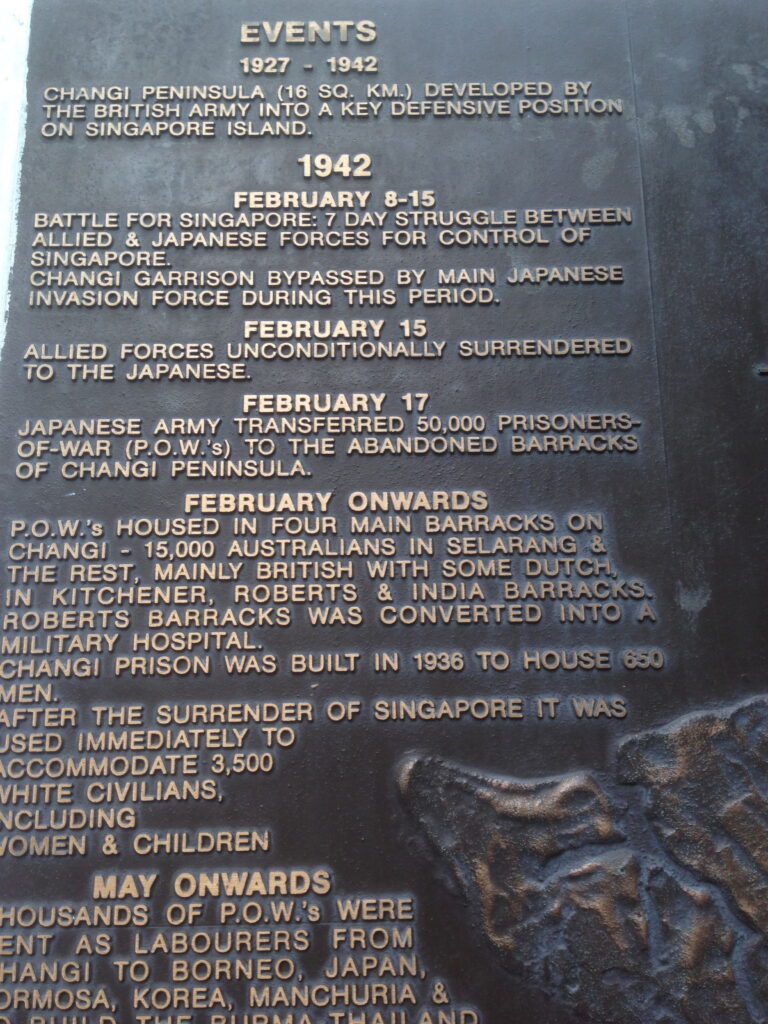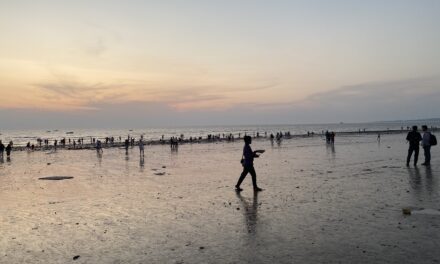“I thought it was a fight against insanity if you could really keep your mind occupied by having some form of intellectual activity. You weren’t sure what the long-term effect of imprisonment or malnutrition and disease would be. but at least I knew if I was going to survive, I was going to survive as a person, not as a vegetable.”
~ Stanley Warren, British POW ~

He was a prisoner of war, extremely sick, an inmate of Changi Prison in 1942, during the Japanese occupation of Singapore, when he painted the five Changi murals on the walls of the St. Luke’s Chapel in Roberts Barracks. A wonderful attempt by a man who could paint to lift the spirits of the thousands interned with him, send a message of hope. In the bargain maybe he also got a shot at keeping sane. I heard of Stanley Warren for the first time this afternoon when quite by chance, if anything is by chance that is, we walked into the Changi Chapel Museum after our walk.

Long before Changi became an airport in my mind, it was a prison. A terrifying one. I had heard of how INA soldiers who were fighting to free India from the British, among them many women, were incarcerated here during WWII. My knowledge of history is sketchy, but there was always a sense of danger, adventure and something really inexorable about the word Changi.

I wanted to see this prison I told AJ. So we met at the petrol station in front of it this morning and walked along the boundary walls of the huge prison complex, going right around it. Took us almost 45 minutes to do just that, I was totally unprepared for the sheer size of the place. The red and white buildings housed the women’s prison, AJ joked the blue ones must be for the men. Right next to the prison was a condominium, then a logistics company’s huge offices. Only in Singapore, I thought.
Everything looked so normal, the jail might have been an office complex, though, yes, there were some barbed wire and a couple of watch towers.
Changi Prison has been integrated into the living space all around, nothing felt scary. I didn’t get the kick in my gut I thought I would when I stood before this historic place. However, a couple of walls had that blank look, something impenetrable about them. All along one side of it there were woods, a green belt, with a wild untamed beauty.


We wondered whether we should go and see the prison hospital, AJ was keen, it was supposed to be haunted. I asked him if he had heard of the Changi Chapel, built by an Australian POW. Chapel? AJ changed his mind. Yes, we’d go there. We started following the map on his phone and walked ahead determinedly… going in the wrong direction.
Thank G for kind passersby. We realised our mistake pretty soon and turned around.
Honestly ,nothing had prepared me for the moving, serene and deadly terrifying museum we found there. It’s a spare clean space, no drama, no song and dance, Just things from those days told of simply… pictures that one will never forget. Words of inmates. Notes and knick-knacks of civilians who were also thrown into prison in a peculiar frenzy of jailing. Things belonging to POWs who worked on the Death Railway. Among them an aluminium tin carried by one who engraved the names of each place they were taken to, the distance, the dates.
Death Railway, the Burma-Thailand Railway I think it’s called, the movie Bridge on the River Kwai was based on this.
I thought of Charles Simon, a wonderful 88 year old Singaporean gentleman I met here, he had worked on that infamous railway and later in a labour camp in Japan. “Disgraceful!” he’d said as he grimaced while talking about the film, “The Americans were never there.”

Before a part of the original wall of Changi Prison lay a plan drawn out on the floor of a typical cell. There were quotes from people who were imprisoned during the occupation that lasted from 15 February, 1942 to 15 August, 1945. The horror of the times clear in the unrehearsed, everyday words.
“The Indian troops were the largest national army defending Malaya and Singapore,” read a panel. I stood transfixed, a sadness in me, I had no idea. “This resulted in the Indians accounting for more than 60 percent of the total allied casualties suffered in the campaign,” how come, I wondered, we never read all this in history classes in school. I asked about the INA, not much was known but the helpful lady at the museum said I should check at the Kranji War Memorial.

The chapel was a replica, but the brass cross in it was the original one made by British POW Staff Seargent Harry Stogen. Without appropriate tools and materials, he’d crafted it from scraps of brass and a 4.5 inch Howitzer (artillery) shell. Plastic red poppies and a real red hibiscus lay near the cross. Next to it in a box was sand from the beaches of Singapore where much of the killing took place, there were candles one could light in the memory of the dead.
Changi Prison was built in 1936, the year my mother was born, and was designed as a civilian prison meant for 650 people. Soon after the Fall of Singapore, 3,500 people were thrown into it.

There were so many feelings in me as I walked past the panels, the artifacts, as I stood in the chapel. Hardly any tourists, just those that were really interested to know about that time or those POWs or the helpless civilians who could only quietly go to jail when told to. There was this memory from a little child called Sybil, of how one minute they were in their huge bungalow and the next in a place with low beds and no real bathrooms.
Strange, I thought… it all happened not that long ago… just 15 years before I was born in fact. Yet in today’s life, in our sights, our sounds, our motivations and shenanigans… not a trace of it. Nothing. Felt like something was not right. I had not forgotten, I had not even known.
“The night that they marched us from Pierce Road to Changi, 30,000 and more, in formation of eight with Japanese guards for every 200 of us. And those humble Chinese along Serangoon Road bringing out basins of water with tin cups for us to drink, and getting slapped for it. they showed a lot of courage.”
~ David Marshall, lawyer ~ He would be the first Chief Minister of Singapore later.

………………………………………………………………………………………………………………………..
Road to Singapore | Changi prison, Changi Chapel Museum, Upper Changi Road North, Tanah Merah Besar Road, 02/05/2015 #SG50
End of 1997, we moved to Singapore from India. In 2015, the country celebrated fifty years of independence. Singapore has given me much and I am fascinated by the spirit of this gutsy city state with hardly any land or resources, but oh what dreams and chutzpah (the finest interpretation of the word), the ability to reach big, hunker down and hold and strategise and act and grow. Despite my many years here, I hadn’t seen a lot of the island, which started out at only 28 miles by 18. Now of course it’s bigger, thanks to that spirit I spoke of. So, Anthony John or AJ, my walking partner, and I decided to do fifty walks in the island to celebrate #SG50. Well, we didn’t stop at fifty; couldn’t. There was still so much to see and feel and also how not to let the hot, merciless, climate-change sun not have its way with us. Come along for the walk talk, try to bring an umbrella.






